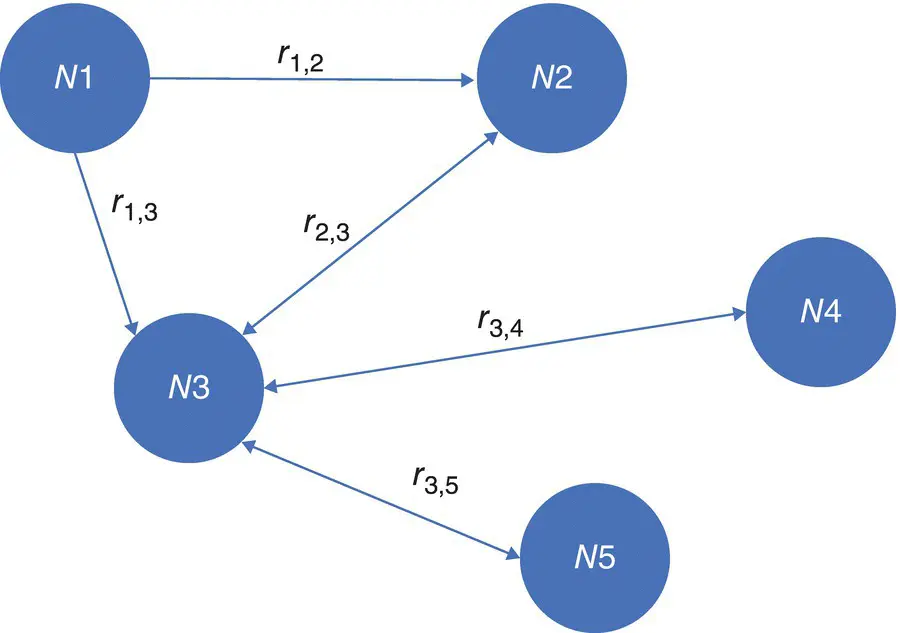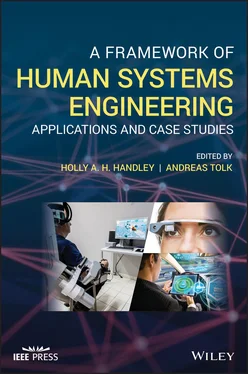A Framework of Human Systems Engineering
Здесь есть возможность читать онлайн «A Framework of Human Systems Engineering» — ознакомительный отрывок электронной книги совершенно бесплатно, а после прочтения отрывка купить полную версию. В некоторых случаях можно слушать аудио, скачать через торрент в формате fb2 и присутствует краткое содержание. Жанр: unrecognised, на английском языке. Описание произведения, (предисловие) а так же отзывы посетителей доступны на портале библиотеки ЛибКат.
- Название:A Framework of Human Systems Engineering
- Автор:
- Жанр:
- Год:неизвестен
- ISBN:нет данных
- Рейтинг книги:4 / 5. Голосов: 1
-
Избранное:Добавить в избранное
- Отзывы:
-
Ваша оценка:
- 80
- 1
- 2
- 3
- 4
- 5
A Framework of Human Systems Engineering: краткое содержание, описание и аннотация
Предлагаем к чтению аннотацию, описание, краткое содержание или предисловие (зависит от того, что написал сам автор книги «A Framework of Human Systems Engineering»). Если вы не нашли необходимую информацию о книге — напишите в комментариях, мы постараемся отыскать её.
A Framework of Human Systems Engineering
Applications and Case Studies
A Framework of Human Systems Engineering: Applications and Case Studies
A Framework of Human Systems Engineering — читать онлайн ознакомительный отрывок
Ниже представлен текст книги, разбитый по страницам. Система сохранения места последней прочитанной страницы, позволяет с удобством читать онлайн бесплатно книгу «A Framework of Human Systems Engineering», без необходимости каждый раз заново искать на чём Вы остановились. Поставьте закладку, и сможете в любой момент перейти на страницу, на которой закончили чтение.
Интервал:
Закладка:
To illustrate the necessity for computational aids, consider the example of a system development effort with five stakeholders. The connections between the stakeholders form a network, albeit not a fully connected network, as shown in Figure 3.5, where stakeholders are represented as nodes in the directed graph and the interactions between the stakeholders are shown as arcs. Thus, the set of stakeholders N = { N 1, N 2, N 3, N 4, N 5} and the relationships between them are described as r x,ywhere x and y are stakeholders X and Y .

Figure 3.5 Example project social network.
The relationship between the stakeholders r x,ycan be represented as r x,y( d, s, a ) where d , s , and a are defined as follows:
d represents directionality: In Figure 3.5, r1,3 is shown as stakeholder 1 influencing stakeholder 3, but not vice versa. Compare this to r3,4 where this influence is bidirectional. In long‐lived capability development environments, a given relationships rx,y may not persist over time, or new relationships may emerge. Failure to recognize the network structure between relationships can result in unintended consequences that likely inject adverse effects into the development cycle or operations of the ensuing system.
S indicates strength of influence: Strength of influence is defined as the degree to which the change in one node affects another. The strength of influence can be positive, negative, or neutral. Upon a change in a stakeholder, positive influence will increase the value of the temporal sociotechnical measures, negative influence will decrease them, and neutral influence indicates that a change in one node will have no effect on the other. For example, in Figure 3.5, if N1 was the leader of the organization, it is reasonable to assume that the r1,3(s) would be strongly positive. The diagram above also indicates that the leader is not significantly influenced by stakeholder N3 as arc is unidirectional; in other words, the leader is not listening. Similarly, the discussion with respect to relationships and the strength of influence of a relationship may change over time.
a is the alignment between stakeholders: Alignment (a) is defined as the difference between the beliefs in both project execution and the underlying project ecosystem between stakeholders. Large differences in beliefs may portend risk as tactical measures may be taken that are not congruent with the success metrics of the parties and larger strategic measures of success may be out of alignment. The alignment is explicitly assessed using the temporal sociotechnical measures, such as the previously discussed belief approach. Whereas the relationship and strength of influence form the underlying substrata for sociotechnical network, risk is directly assessed by alignment (or lack thereof) of the belief structures of the stakeholders.
As a system development effort progresses, evidence is presented to the stakeholders that affects their beliefs. AI models of stakeholders can be used to model how beliefs can morph and drive how the stakeholder processes evidence and chooses actions. Understanding and modeling how misaligned belief structures can result in actions that are counter to overall goals of the development effort is key to proactively managing emerging risks. Frameworks such as belief, desire, and intention (Kim et al., 2012) have been used successfully in developing high‐fidelity agent‐based models and can be used here.
Accurate AI modeling of stakeholders using digital twin concepts provides a solid representation of the stakeholders and mechanism to track the evolution of the preferences. These AI‐based risk assessors can look at atomic measures, group measures, and holistic sociotemporal measures to assess risks as shown in Figure 3.5. Structural risk can be assessed using appropriate interpretations of the sociotechnical network, consistently looking for over‐connectiveness as well as sparsity. Structural risks are identified when measures exceed the tolerance of network metrics within a degree of error.
The canonical definition of risk can be described as a tuple represented as risk{event, likelihood, consequence} . Using this definition, AI‐based models can spot misalignment across the sociotechnical measures and have the added capability of identifying localized risk, enterprise level risks, and emergent risks as misalignment grows over time. Further, with the introduction of evidence, and stakeholders’ interpretation, may result in the identification of hidden risks. For example, a significant reduction in electronic communication between certain stakeholders can be a signal if impending misalignment and the advent of a relational risk. Relational risk occurs when a risk assessor looks at the relationship between two stakeholders and identifies significant incongruence between the sociotemporal measures leading to a lack of alignment. Here again the application of AI can model incidental and emerging risks as the scale of a large enterprise and the rapid pace of change make typical knowledge acquisition efforts across the stakeholders unrealistic. AI‐based models can assist in proactive decision support when coupled with SE to identify measures, establish metrics, and define acceptable deviation limits for the measure.
A large enterprise may have tens or even hundreds of relevant stakeholders, all of whom are seeing different aspects of the development effort. As evidence is introduced to stakeholders in these complex sociotechnical networks, it is improbable that manual, or mental, methods can adequately track and assess the impact of the evidence. AI‐based models can easily track and learn from these events and provide the practitioner with insight on how best to lower risk and improve value delivery.
Traditional risks in typical system development projects and their evolution are well documented in literature (Warkentin et al., 2009), but analytical analysis of risk particularly in the sociotemporal space is largely a manual process. An AI‐based risk assessor can monitor trends in the sociotechnical measures to examine if there are emerging risks from a growing misalignment between groups of stakeholders. An AI risk assessor can develop forecasts of emerging risks that can be modeled by deliberate introduction of possible evidence that may occur in the future. Modeling in this fashion provides the capability to proactively assess system risk areas and take preventive steps.
In addition to localized risk identification, a holistic view of systemic risk across the sociotechnical ecosystem becomes more feasible using AI‐based models. While localized gross individual misalignment may not manifest itself, a general trend toward misalignment across the enterprise can be discovered and identified. Whereas the values for sociotemporal measures typically have been discovered through interviews, AI offers the opportunity to make assessments based upon noninvasive approaches such as analyzing e‐mails and text messages. Applications like the hedonometer (Dodds et al., 2011) have been used for many years; it is suggested here that AI can tap into the results of the hedonometer for both localized and global assessments of risk.
The second element in the risk tuple is the likelihood that the risk will occur. Misalignment on the sociotechnical measures provides an indication of an impending risk event. Traditional uncertain reasoning approaches, e.g. using a Bayesian network, can be employed to determine the likelihood of the risk (Feng et al., 2008; Hui and Liu, 2004). If the misalignment is observed, there is a certitude that the risk event has now become an issue, at which point the AI can be used to make an estimate of the consequences should the issue not be resolved in a timely fashion.
Читать дальшеИнтервал:
Закладка:
Похожие книги на «A Framework of Human Systems Engineering»
Представляем Вашему вниманию похожие книги на «A Framework of Human Systems Engineering» списком для выбора. Мы отобрали схожую по названию и смыслу литературу в надежде предоставить читателям больше вариантов отыскать новые, интересные, ещё непрочитанные произведения.
Обсуждение, отзывы о книге «A Framework of Human Systems Engineering» и просто собственные мнения читателей. Оставьте ваши комментарии, напишите, что Вы думаете о произведении, его смысле или главных героях. Укажите что конкретно понравилось, а что нет, и почему Вы так считаете.












